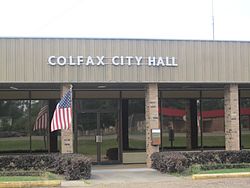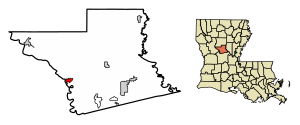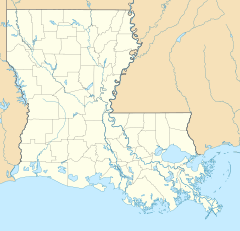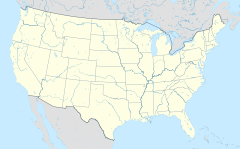Colfax, Louisiana facts for kids
Quick facts for kids
Colfax, Louisiana
|
|
|---|---|
| Town of Colfax | |

Colfax City Hall
|
|

Location of Colfax in Grant Parish, Louisiana.
|
|
| Country | |
| State | |
| Founded | 1869 |
| Parish seat | Grant Parish |
| Metropolitan area | Alexandria |
| Government | |
| • Type | Mayor |
| • Body | Gerald Hamilton (D) |
| Area | |
| • Total | 1.50 sq mi (3.88 km2) |
| • Land | 1.49 sq mi (3.86 km2) |
| • Water | 0.01 sq mi (0.02 km2) |
| Elevation | 100 ft (30 m) |
| Population
(2020)
|
|
| • Total | 1,428 |
| • Rank | GR: 1st |
| • Density | 957.75/sq mi (369.73/km2) |
| Time zone | UTC-6 (CST) |
| • Summer (DST) | UTC-5 (CDT) |
| ZIP code |
71417
|
| Area code | 318 |
Colfax is a town in Grant Parish, Louisiana, United States. It is also the main town, or parish seat, of Grant Parish. Colfax was founded in 1869. It is part of the larger Alexandria, Louisiana metropolitan area. In 2020, about 1,428 people lived in Colfax. Most of the people living here are African American.
Contents
History of Colfax
Colfax is well-known for an important and sad event from the Reconstruction Era. This period was after the American Civil War. On April 13, 1873, a terrible event known as the Colfax massacre took place.
This event happened because of a disagreement over an election for governor in Louisiana in 1872. Both sides claimed they had won. In Colfax, groups of armed men clashed over who should be in charge. Many African Americans had gathered at the county courthouse to protect their right to vote and support their chosen officials.
During the conflict, many people were killed. Most of those who died were African Americans. Because so many more African Americans died, and some were killed after they had surrendered, historians now call this event a massacre. This event was very important because it showed how difficult it was for African Americans to gain and keep their political rights after slavery ended.
After this event, in 1874, a group called the White League was formed. This group worked to scare and attack African American voters. They also tried to remove Republican officials from office. Federal troops stayed in Louisiana until 1877 to help keep peace.
In 1921, a large marble monument was put up in Colfax. It honored three white men who died during the event. The monument described their actions as "fighting for White Supremacy." Later, in 1950, a historical marker was placed that called the event a "riot" and said it "marked the end of carpetbag misrule in the South." These markers show how different groups remembered and described the event over time.
Today, the Red River Heritage Association is working to create a museum in Colfax. This museum will help people learn about the history of Reconstruction in Louisiana.
Geography of Colfax
Colfax is located in the western part of Grant Parish. It sits on the northeast side of the Red River. The town is about 100 feet above sea level.
Louisiana Highway 8 goes through the middle of Colfax. This highway leads east to U.S. Route 71. It also goes south to Boyce, which is about 12 miles away. The city of Alexandria is about 26 miles to the southeast.
According to information from 2010, Colfax covers a total area of about 1.5 square miles (3.9 square kilometers). Only a very small part of this area is water.
People in Colfax
| Historical population | |||
|---|---|---|---|
| Census | Pop. | %± | |
| 1870 | 40 | — | |
| 1890 | 161 | — | |
| 1900 | 190 | 18.0% | |
| 1910 | 1,049 | 452.1% | |
| 1920 | 1,449 | 38.1% | |
| 1930 | 1,141 | −21.3% | |
| 1940 | 1,354 | 18.7% | |
| 1950 | 1,651 | 21.9% | |
| 1960 | 1,934 | 17.1% | |
| 1970 | 1,892 | −2.2% | |
| 1980 | 1,680 | −11.2% | |
| 1990 | 1,696 | 1.0% | |
| 2000 | 1,659 | −2.2% | |
| 2010 | 1,558 | −6.1% | |
| 2020 | 1,428 | −8.3% | |
| U.S. Decennial Census | |||
Population in 2020
| Race | Number | Percentage |
|---|---|---|
| White (non-Hispanic) | 532 | 37.25% |
| Black or African American (non-Hispanic) | 834 | 58.4% |
| Native American | 1 | 0.07% |
| Asian | 4 | 0.28% |
| Other/Mixed | 41 | 2.87% |
| Hispanic or Latino | 16 | 1.12% |
In 2020, there were 1,428 people living in Colfax. There were 686 households and 470 families in the town.
Education in Colfax
Public schools in Grant Parish are managed by the Grant Parish School Board. The old Colfax High School joined with Grant High School in Dry Prong. Now, the only school in Colfax itself is Colfax Elementary School. Students from Colfax attend Grant High School for their high school education.
Notable People
- Allison Kolb: He was the state auditor for Louisiana from 1952 to 1956. He was born in Colfax.
- W. T. McCain: He served as a state representative for Grant Parish.
Images for kids
-
Colfax Elementary School; pupils in Colfax attend Grant High School in nearby Dry Prong.
-
First United Methodist Church in Colfax
See also
 In Spanish: Colfax (Luisiana) para niños
In Spanish: Colfax (Luisiana) para niños







